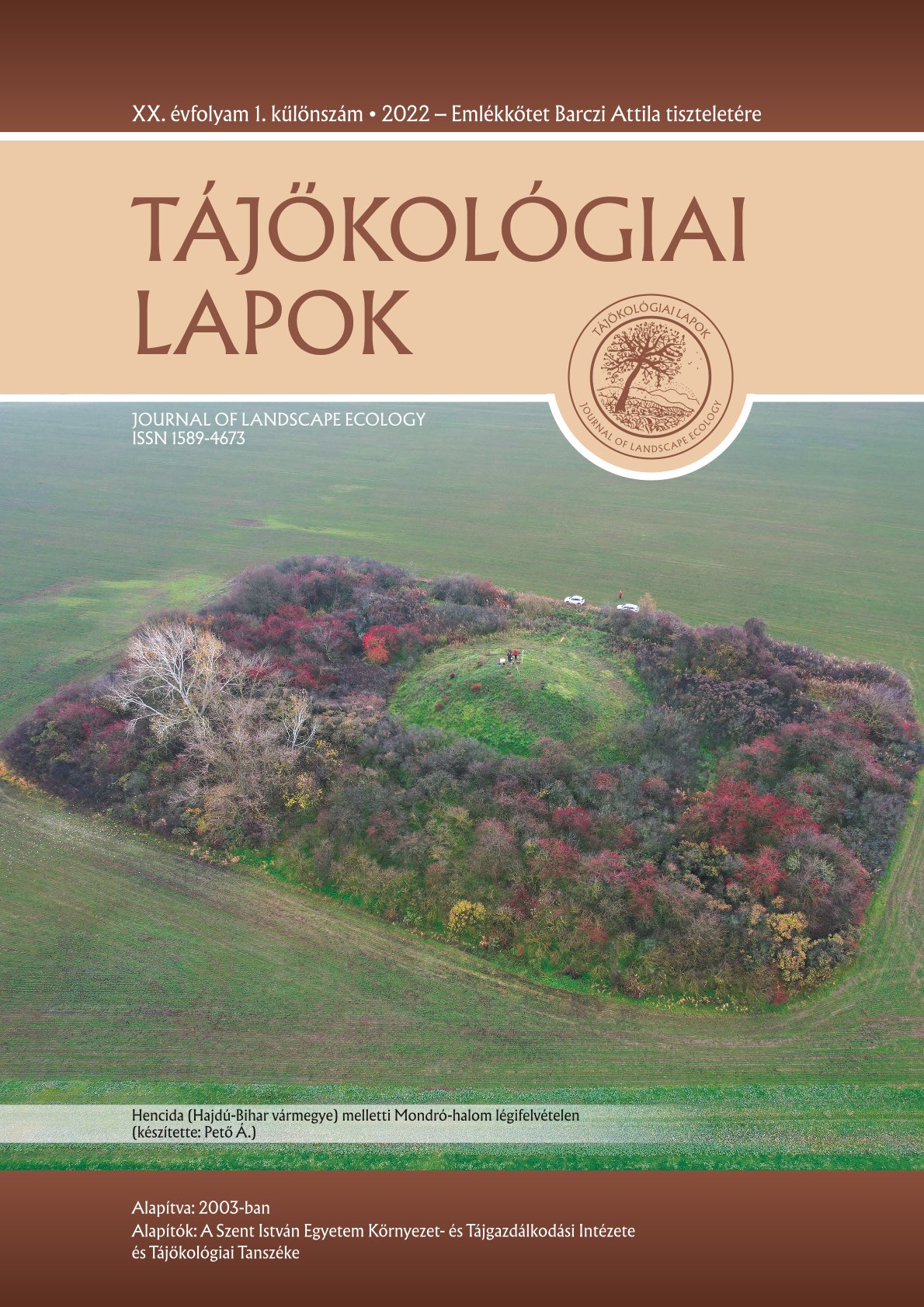Effects of Sewage Sludge Compost Applications on the Soil CO2-Respiration, the Nutrient and Heavy Metal Content of Chernozem Soils
DOI:
https://doi.org/10.56617/tl.3152Keywords:
agricultural treatment, soil respiration, toxic elements, fertilizing, soil qualityAbstract
Sewage sludge contains organic matter, micro and macronutrients which are potentially useful for agricultural usage. Additionally, soil CO2-respiration can improve and CO2 can build into the soil which decreases the atmospheric carbon dioxide. However, it can be harmful when containing undesirable amounts of organic pollutants and heavy metals. Our study focused on examining the soil CO2-respiration, the changes in the extractable nutrient, organic matter and heavy metal contents of a chernozem soil as a consequence of low-dose municipal sewage sludge compost applications (2,5-35 m3/ha/year). Sampling and measurement campaigns were done in 2018 and 2019 near Újkígyós and Kardos (SE-Hungary) during which composite soil samples (0-30 cm and 30-60 cm) and groundwater samples were collected for assessing changes in the nutrient and heavy metal concentrations (in Újkígyós) as a result of compost amendments’ use and CO2-respiration were measured 5 times both in Újkígyós and Kardos. Soil samples were analyzed for the basic pedological parameters (pH, organic matter, carbonates and texture), nutrients (K2O, P2O5, N-forms and organic matter) and heavy metal concentrations following standard extraction procedures. The results of the nutrient analyses show significantly increased soil-bound K2O, P2O5 and NO2-+NO3- contents linked to the sewage sludge treatments. However, neither the organic matter nor the heavy metal content varied significantly in the sludge-amended soil compared to a control site. Similarly, there was no obvious evidence to verify the increasing CO2 respiration after sewage sludge treatments on any study plots. Overall, these results convincingly demonstrated that amending soils with low doses of municipal sewage sludge composts (lacking any industrial sources) can be a sustainable fertilizing practice taking advantage of their high N, P and K contents that are slowly converted to their bioavailable forms thus preventing their excessive leaching in the groundwater. The applied doses were presumably too low for significant changes in soil CO2 respiration.
References
/2001. (IV. 3.) Kormányrendelet a szennyvizek és szennyvíziszapok mezőgazdasági felhasználásának és kezelésének szabályairól.
/2009. (IV. 14) KvVM-EüM-FVM együttes rendelet a földtani közeg és a felszín alatti víz szennyezéssel szembeni védelméhez szükséges határértékekről és a szennyezések méréséről.
Abubakari, M., Moomin, A., Nyarko, G., Dawuda, M.M. 2017: Heavy metals concentrations and risk assessment of roselle and jute mallow cultivated with three compost types. Annals of Agricultural Sciences 62(2): 145–150. DOI: https://doi.org/10.1016/j.aoas.2017.11.001
Anda A. 2016: Mezőgazdaság: fő tényező a globális felmelegedésben? Agrárium 6–7: 79–81.
Diacono, M., Montemurro, F. 2011: Long-Term Effects of Organic Amendments on Soil Fertility. In: Lichtfouse E., Hamelin M., Navarrete M., Debaeke P. (eds): Sustainable Agriculture Volume 2. Springer, Dordrecht. DOI: https://doi.org/10.1007/978-94-007-0394-0_34
Doetterl, S., Berhe, A. A., Nadeu, E., Wang, Z., Sommer, M., Fiener, P. 2016: Erosion, deposition and soil carbon: A review of process-level controls, experimental tools and models to address C cycling in dynamic landscapes. Earth-Science Reviews 154: 102–122. DOI: https://doi.org/10.1016/j.earscirev.2015.12.005
Kovács Gy. 2014: Mezőgazdasági hasznosítású talajok szén-dioxid-emissziójának vizsgálata Karcag térségében. Doktori disszertáció, Debrecen. p. 144.
McGrath, S.P., Zhao, F.J., Dunham, S.J., Crosland, A.R., Coleman, K. 2000: Long-Term Changes in the Extractability and Bioavailability of Zinc and Cadmium after Sludge Application. Journal of Envi-ronmental Quality 29(3): 875–883. DOI: https://doi.org/10.2134/jeq2000.00472425002900030025x
MSZ-08-0206-2 1978: A talaj egyes kémiai tulajdonságainak vizsgálata. Laboratóriumi vizsgálatok (pH-érték, szódában kifejezett fenolftalein lúgosság, vízben oldható összes só, hidrolitos (y1-érték) és kicserélődési aciditás (y2-érték)). Mezőgazdasági és Élelmezésügyi Minisztérium, Budapest. p. 12.
MSZ 21470-52 1983: Környezetvédelmi talajvizsgálatok. Talajok szervesanyag-tartalmának meghatározása. Magyar Szabványügyi Hivatal, Budapest. p. 12.
Oh, N.H., Kim, H.S., Richter, D.D 2005: What Regulates Soil CO2 Concentrations? A Modeling Approach to CO2 Diffusion in Deep Soil Profiles. Environmental Engineering Science 22(1): 38–45. DOI: https://doi.org/10.1089/ees.2005.22.38
Pinamonti, F., Stringari, G., Gasperi, F., Zorzi, G. 1997: The use of compost: its effects on heavy metal levels in soil and plants. Resources, Conservation and Recycling 21(2): 129–143. DOI: https://doi.org/10.1016/S0921-3449(97)00032-3
PP Sytems 2018: EGM-5 Portable CO2 Gas Analyzer Operation Manual. PP Systems, Amesbury. p. 129.
Qi, G., Jia, Y., Liu, W., Wei, Y., Du, B., Fang, W., Guo, Y., Guo, F., Wu, Y., Zou, Q., Liu, J. 2020: Leaching behavior and potential ecological risk of heavy metals in Southwestern China soils applied with sewage sludge compost under acid precipitation based on lysimeter trials. Chemosphere 249: 126212. DOI: https://doi.org/10.1016/j.chemosphere.2020.126212
Tóth E., Koós S., Farkas Cs. 2008: A talaj szén-dioxid emissziója és nedvességtartalma közötti kapcsolat vizsgálata talajművelési tartamkísérletben. In: Simon L. (szerk.): Talajvédelem különszám. Talaj-tani Vándorgyűlés, Nyíregyháza. 175–184.
Tóth, M., Fekete, I., Barta, K., Farsang, A. 2020: Measurement of soil CO2 respiration on arable land treat-ed by sewage sludge compost. Geosciences and Engineering 8(12): 305–311. URL: https://ring2017.uni-miskolc.hu/files/12661/Ring_Special_Issue_of_Geosciences_and_Engineering.pdf
Downloads
Published
Issue
Section
License
Copyright (c) 2022 Barta Károly, Babcsányi Izabella, Farsang Andrea, Tóth Máté, Fekete István, Ladányi Zsuzsanna, Csányi Katalin Tímea

This work is licensed under a Creative Commons Attribution-NonCommercial-NoDerivatives 4.0 International License.
A folyóirat Open Access (Gold). Cikkeire a Creative Commons 4.0 standard licenc alábbi típusa vonatkozik: CC-BY-NC-ND-4.0. Ennek értelmében a mű szabadon másolható, terjeszthető, bemutatható és előadható, azonban nem használható fel kereskedelmi célokra (NC), továbbá nem módosítható és nem készíthető belőle átdolgozás, származékos mű (ND). A licenc alapján a szerző vagy a jogosult által meghatározott módon fel kell tüntetni a szerző nevét és a szerzői mű címét (BY).












